Understanding the Cost of a Three Carat Diamond
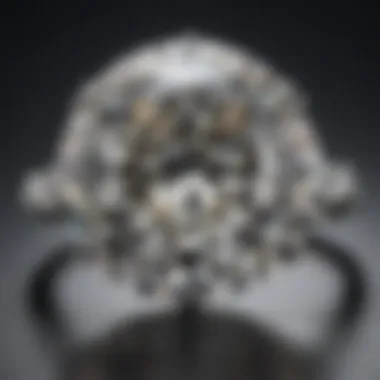
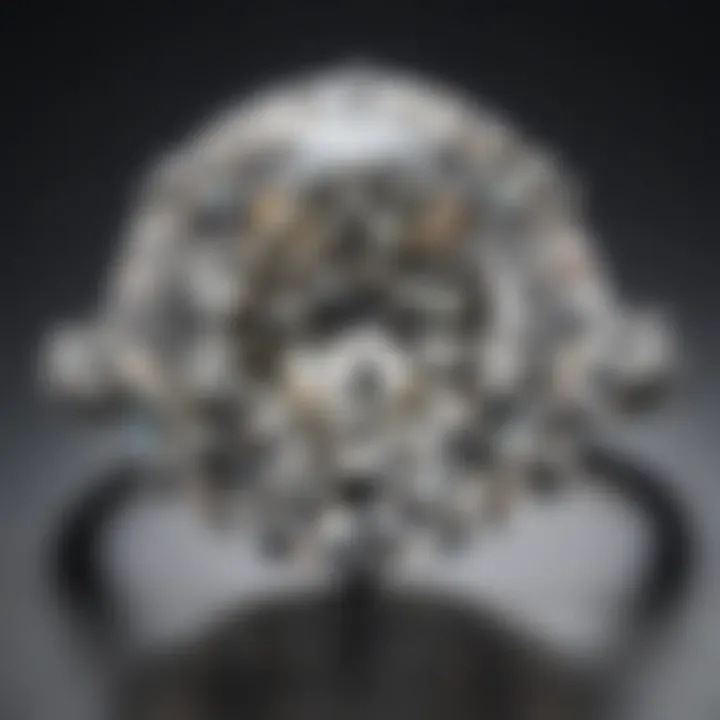
Intro
Purchasing a diamond ring, especially a three carat one, can be an intricate endeavor. The complexity arises from multiple variables that contribute to the final price. This article delves into the elements influencing the cost, specifically concentrating on the four Cs: carat, cut, clarity, and color. By examining these factors in detail, prospective buyers can make well-informed choices.
Gemstone Overview
Definition and Origins
Diamonds are a form of carbon, renowned for their brilliance and durability. Formed under high pressure and temperature conditions deep within the Earth's mantle, these gemstones have captivated humans for centuries. Their journey from the earth to the jewelry store is complex, involving extraction, cutting, and polishing. This transformation enhances their aesthetic appeal significantly.
Historical Significance
Throughout history, diamonds have carried immense value. In ancient times, they were considered symbols of strength and invincibility. Royalty often adorned themselves with diamond-encrusted artifacts, making them a standard of wealth and power. Today, the significance of diamonds continues, especially in engagement rings, where they symbolize love and commitment.
Gemstone Properties
Hardness and Durability
Diamonds are the hardest known natural material, scoring a 10 on the Mohs scale of mineral hardness. Their durability makes them suitable for daily wear, particularly in engagement rings. This characteristic enhances their value, as customers often seek a stone that can withstand the rigors of everyday life.
Color and Clarity
The color of a diamond can significantly impact its price. The ideal diamonds are colorless. However, many possess slight hues that can reduce their value. Similarly, clarity refers to the presence of internal or external flaws. A high-quality diamond will have minimal inclusions, which makes it more desirable. Understanding these aspects is crucial for buyers aiming for a captivating ring.
"A diamond's value increases with its clarity and proximity to being colorless."
By grasping these essential properties, consumers can better navigate the complexities of purchasing a diamond ring. This knowledge will enhance their confidence when selecting the perfect three carat diamond ring.
Prelims
The purchase of a three carat diamond ring is a significant investment and a process that warrants careful consideration. This article delves into the complexities behind the cost of such a ring, providing insight that can benefit potential buyers and enthusiasts alike. Understanding diamond pricing is essential for anyone looking to make an informed decision.
In the world of gemstones, carat weight remains one of the most recognized attributes of a diamond. However, it is not the only factor influencing its cost. A multitude of elements comes into play, ranging from market trends to certification. This article aims to unravel these factors, presenting a clearer picture of what affects the price of a three carat diamond.
Potential buyers should note that each carat is not created equal. The unique characteristics of each diamond contribute significantly to its market value. By exploring these nuances, individuals can better navigate their options and understand why certain diamonds command higher prices than others.
"Understanding the nuances of diamond pricing can empower buyers in a competitive market."
This journey into the world of diamonds will cover essential topics such as the importance of carat weight, the role of cut, clarity, and color, as well as the impact of current market conditions. By examining these factors in detail, this article serves to demystify the often opaque pricing structures within this industry.
This knowledge is particularly useful for gemstone enthusiasts, jewelry designers, and collectors looking to make informed choices. Ultimately, the goal is to equip readers with a comprehensive understanding that will facilitate prudent and informed purchases.
The Importance of Carat Weight
Carat weight is fundamental when considering a diamond ring, especially for a three carat piece. It not only influences how impressive the stone appears but also significantly affects its price. Understanding carat weight helps potential buyers gauge value and rarity. A larger diamond usually commands higher pricing. However, carat weight is just one piece of the puzzle; it interacts with other characteristics that can also affect the overall cost and desirability of the ring.
Defining Carat Weight
Carat weight measures a diamond's size and weight, with one carat equating to 200 milligrams. It is often perceived as the most critical factor in a diamond’s value. Buyers equate larger diamonds with more luxury and status, making this aspect crucial in purchasing decisions. Diamonds can be weight measured in points, where 100 points equals one carat. A three carat diamond would weigh 600 milligrams, thus usually appearing larger and more dazzling. Buyers should note that two diamonds of equal carat weight can differ in size based on cut, shape, and proportions.
Impact of Carat Weight on Price
When evaluating the price of a three carat diamond ring, it is essential to recognize how carat weight influences cost directly. Generally, as carat weight increases, the price per carat also tends to rise significantly. This is due to the exponential nature of demand; as weight increases, availability of high-quality stones diminishes.
For instance, a two carat diamond may cost considerably less than a three carat stone, even when both are of similar quality. This pricing anomaly occurs because three carat diamonds are less common. Furthermore, potential buyers must also consider grading factors that come into play with weight. A three carat diamond that is of lower clarity or color quality could be less expensive than a smaller diamond of superior characteristics.
Thus, while carat weight is a significant consideration for any buyer, it is important to also regard other quality factors, including cut, clarity, and color, to make a well-informed decision.
Understanding the Four Cs
The Four Cs are crucial in determining the quality and value of a diamond. They stand for Carat, Cut, Clarity, and Color. Each factor influences the overall appearance and price of a diamond ring significantly. Understanding these elements equips buyers with better insights, allowing them to make informed decisions when purchasing a three carat diamond ring.
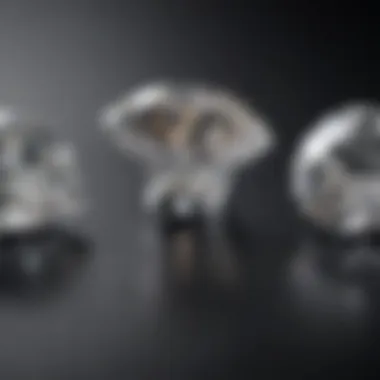
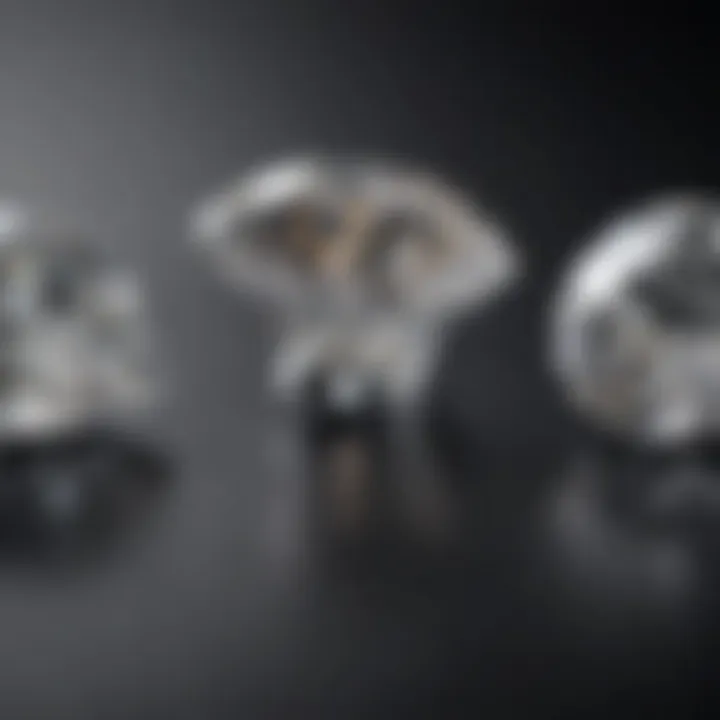
Focusing on the Four Cs means appreciating not just the physical attributes of the diamond but also understanding how they interrelate. For example, an excellent cut can enhance a diamond's visual appeal, even if its carat weight is on the lower side. Thus, buyers must grasp how these qualities contribute collectively to the value of the diamond.
In this section, we will delve into each specific attribute, providing insight into their significance and impact on a diamond's pricing.
Cut
The Cut is arguably the most vital of the Four Cs. It influences how a diamond interacts with light, which in turn affects its brilliance. A well-cut diamond reflects light in such a way that it maximizes sparkle, making it desirable. Different cuts, such as round, princess, and oval, come with unique characteristics that enhance their visual appeal.
Buyers must be aware that even diamonds with the same carat weight can vary widely in price depending on their cut. A diamond with a perfect cut can appear larger and more luminous than one with an inferior cut of equal carat size. Thus, examining the cut grade can help ascertain the diamond's actual value.
Clarity
Clarity refers to the presence of internal or external flaws known as inclusions and blemishes. These imperfections are graded by gemological institutions and can significantly influence the value of a diamond. Higher clarity grades mean fewer visible flaws, leading to higher prices.
Evaluating clarity involves understanding the grading scale used by reputable gemological organizations. Buyers should seek clarity grades that suit their personal preferences and budget. In many cases, diamonds with slight inclusions can be more affordable, yet still appear stunning when set in jewelry.
Color
Color measures the whiteness or lack of color in a diamond. The most precious diamonds are colorless, while those with noticeable color tend to be less valued. The color grade ranges from D (colorless) to Z (light yellow or brown).
It is essential to consider the setting of the diamond as well. Certain settings can affect the perception of the diamond's color. For instance, a white gold or platinum setting may enhance the apparent whiteness of a slightly colored diamond, offering a compelling visual presentation.
In summary, understanding the Four Cs provides a detailed framework for evaluating a three carat diamond ring. Recognizing how cut, clarity, and color influence both appearance and price helps potential buyers navigate the complexities of the diamond market.
Market Trends Affecting Pricing
Understanding market trends is crucial when it comes to the pricing of a three carat diamond ring. The diamond market is dynamic and influenced by various elements that can significantly affect costs. By keeping abreast of these trends, consumers can navigate their purchasing timelines more effectively, making informed decisions that align with their budget and preferences.
Current Market Overview
The current market landscape for diamonds reflects both demand and supply dynamics. Recent years have witnessed fluctuations due to economic shifts and buyer behavior. In the luxury segment, three carat diamonds often attract a premium because they are seen as exclusive items. As of now, a trend towards ethical sourcing and sustainable practices has emerged. Buyers are increasingly aware of the origins of their diamonds. This consciousness drives demand for conflict-free production methods which can weigh heavily on prices.
Furthermore, major retailers have also adjusted their inventories due to the changing preferences of younger consumers. Millennials and Generation Z prioritize unique experiences over traditional purchases. Consequently, this shift has resulted in an increase in personalized and custom designs, which can further influence market rates. A well-rounded overview needs to consider these changes and explore how they directly or indirectly impact ring pricing.
Geopolitical Factors
Geopolitical factors play a significant role in the diamond market. Diamonds are often mined in regions that are politically unstable. For instance, disruptions in areas like Africa—one of the primary sources of diamonds—can lead to fluctuations in supply chains. When conflicts arise or when governments impose trade restrictions, the availability of diamonds can decline, causing prices to rise.
Additionally, trade policies and tariffs affect import costs, which translates to higher retail prices for consumers. This variability requires potential buyers to keep an eye on global happenings. Regular monitoring of international news is advisable.
"Understanding the geopolitical landscape helps consumers forecast possible price trends, facilitating more strategic purchasing decisions."
In summary, being aware of current market overviews and geopolitical factors can greatly assist consumers in determining the best time to invest in a three carat diamond ring. By factoring in these variables, buyers can not only save money but also ensure they are making a well-informed decision.
Consumer Preferences and Trends
Understanding consumer preferences and trends provides crucial insight into how individuals approach the purchase of diamond rings, specifically three carat rings. The choices people make are often influenced by various personal factors including style, investment value, and societal norms. A comprehensive grasp of these elements not only sheds light on consumer behavior but also informs retailers and jewelers about market demands and trends that can vary significantly over time.
Popularity of Three Carat Rings
Three carat diamond rings have gained substantial popularity among buyers in recent years. One primary reason for this trend is the increasing interest in conspicuous consumption, where individuals showcase their wealth through their jewelry. Additionally, three carats strikes a balance between elegance and practicality, making it a popular choice for engagement rings.
Statistically, engagements with rings of this size have been noted more frequently on platforms that highlight high-value purchases.
- Factors driving this trend include:
- Social Status: Owning a larger diamond, such as a three carat, symbolizes a certain social standing.
- Symbolism: The size is often associated with love commitments and milestones in relationships.
- Visibility: Larger stones catch the eye, making them a preferable option for many buyers.
As consumer awareness grows about diamond options, three carat rings capture attention for their size without crossing into the realm of ostentatiousness.
Influence of Social Media
Social media has undeniably reshaped consumer habits in the jewelry market. With platforms like Instagram and Pinterest showcasing engagement rings, trends can catch fire quickly. This rapid dissemination of information leads to fluctuations in what styles are deemed desirable.
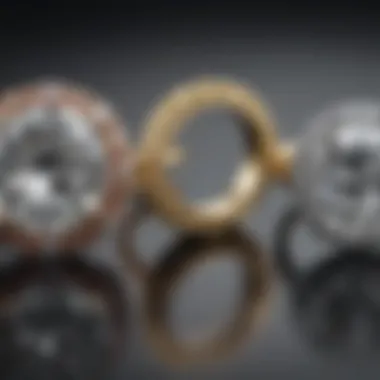

The influence of social media manifests in several ways:
- Visual Inspiration: Images of three carat rings shared by influencers and brands inspire potential buyers and set standards for beauty and desirability.
- User-Generated Content: Couples share their own experiences and choices online, making three carat rings a popular choice, particularly in engagement announcements.
- Accessibility: The internet makes various styles and prices visible to a broader audience, enabling buyers to research and refine their choices effectively.
"Social media lends an unparalleled platform for couples to connect over their jewelry choices, showcasing preferences that influence wider purchasing trends."
Sources of Pricing Variability
Understanding the sources of pricing variability is crucial for prospective buyers of a three carat diamond ring. The price of diamonds, especially those with a higher carat weight, is influenced by a variety of factors beyond the basic characteristics of the stone itself. This section delves into the distinctions between retail and wholesale pricing, as well as the differences between online and in-store purchases. By grasping these elements, you can better navigate the marketplace and make more informed decisions.
Retail vs. Wholesale Pricing
Retail pricing is what most consumers encounter. It reflects the final price that customers pay at stores or online retailers. Factors that contribute to retail pricing include store overhead, marketing expenses, and profit margins. Retailers often provide a polished shopping experience with customer service, return policies, and warranties.
On the other hand, wholesale pricing is generally lower. It is the price at which jewelers purchase diamonds directly from suppliers or manufacturers in bulk. This means retailers markup these stones to cover their expenses and ensure a profit on each sale. The wholesale market operates primarily to serve the retail sector. It offers potential for negotiation and bulk purchases that retail prices typically do not.
- Key Factors Influencing Retail to Wholesale Prices:
- Overhead costs of running a physical store or a comprehensive online platform.
- Marketing and branding efforts that position a retailer in the market.
- Customer service and after-sales support that add value to the retail experience.
Online vs. In-Store Purchases
The decision of whether to buy a diamond ring online or in a physical store significantly impacts pricing. Online retailers often offer lower prices than brick-and-mortar shops. This is due to reduced operating costs, such as rent and utilities. Customers can compare prices easily through various websites, which increases competition among online sellers and often leads to better prices.
In-store purchases provide the advantage of experiencing the diamond in person. Shoppers can assess the stone's visual appeal, clarity, and color under different lighting conditions. Additionally, in-person purchases allow buyers to engage with knowledgeable staff who can answer questions and offer personalized guidance.
- Considerations for Buying Online vs. In-Store:
- Online purchases might offer more competitive pricing but lack the tactile experience.
- In-store purchases provide immediate access to the item but may include a higher markup.
- The option for virtual consultations is increasing as retailers adapt to consumer preferences for digital engagement.
"Ultimately, the choice between online and in-store shopping hinges on personal priorities—whether it’s price sensitivity or the desire for a personalized purchase experience."
Through understanding these sources of pricing variability, buyers can better prepare themselves for the financial aspects of purchasing a three carat diamond ring. Making a well-informed choice requires analyzing both the retail and wholesale landscapes, as well as weighing the pros and cons of online versus in-store purchasing experiences.
Comparative Analysis of Different Jewelers
When purchasing a three carat diamond ring, understanding the distinctions among various jewelers is crucial. Each jeweler offers a different experience and pricing strategy, which can significantly impact the overall cost. This section explores the differences between luxury jewelers and independent jewelers, along with how brand reputation can influence pricing.
Luxury Jewelers vs. Independent Jewelers
Luxury jewelers like Cartier or Tiffany & Co. typically present a refined shopping experience. They offer high-quality diamonds and a premium level of service. Their pricing often reflects not just the diamond's features but also the prestige associated with their name. These jewelers invest in marketing and in-store experiences. This can lead to higher prices for the consumer.
On the other hand, independent jewelers may provide more competitive pricing. They often have lower overhead costs since they might not be located in expensive retail venues. Additionally, they may source their diamonds more flexibly, which can lead to a better selection in certain cases. Independent jewelers can also foster direct relationships with their customers, often resulting in personalized service. You can sometimes negotiate better prices at these stores.
- Pros of Luxury Jewelers:
- Cons of Luxury Jewelers:
- Pros of Independent Jewelers:
- Cons of Independent Jewelers:
- Consistent quality assurance
- Prestigious brand recognition
- High-end customer service
- Higher price points
- Limited room for negotiation
- Competitive pricing
- Greater flexibility in diamond sourcing
- More personalized service
- Variable quality control
- Less brand recognition
Impact of Brand Reputation on Pricing
Brand reputation plays a significant role in diamond pricing. Well-known brands have a reputation built over time, contributing to consumer trust. This makes customers willing to pay more. Reputation affects perceived value, and customers often associate higher prices with better quality.
On the contrary, lesser-known brands may have to work harder to establish their credibility. Customers might see a lower price with skepticism, doubting the quality of the diamonds offered.
In summary, while luxury jewelers assure high-quality products and services, independent jewelers can offer competitive prices and personalized experiences. Understanding these elements helps potential buyers navigate the often complex landscape of diamond purchasing, making informed decisions suitable to their needs.
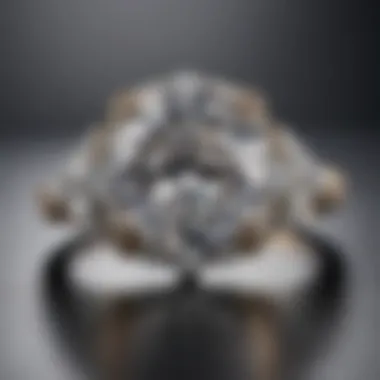
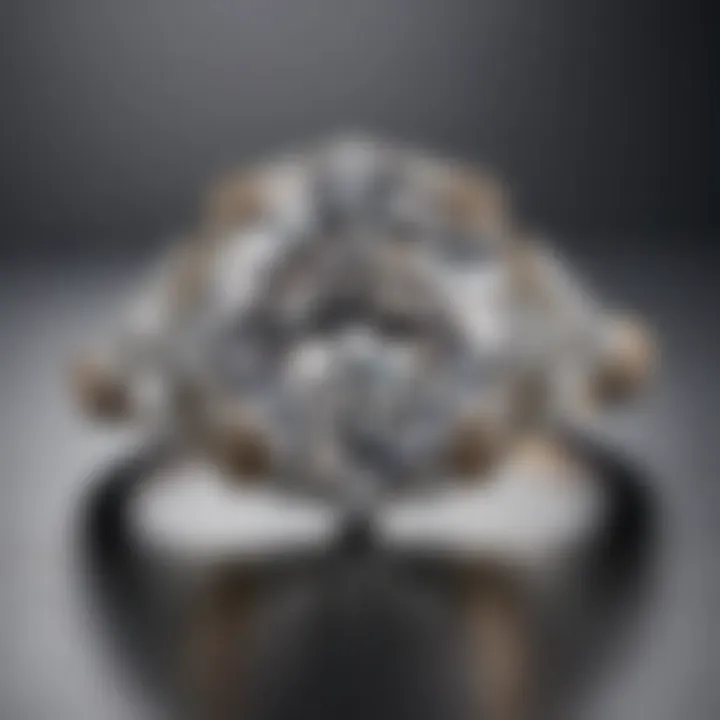
The Role of Certification
The realm of jewelry, particularly when it involves precious stones like diamonds, demands a level of trust and assurance. This is where certification plays a crucial role. It is an essential aspect for buyers who wish to invest in a three carat diamond ring. The primary purpose of certification is to verify that a diamond's characteristics align with what is advertised. This verification ensures that buyers are receiving a product that meets or exceeds their expectations. When considering the cost, certification can directly affect the market value.
Certificates serve as a testament to the quality of a diamond, presenting clear and measurable details of its attributes. They help buyers navigate the complexities of pricing and quality by providing impartial information about the diamond. Without such documentation, consumers rely heavily on the claims made by sellers, which can be subjective and unverified.
"Certificates are the bridge of trust between buyers and sellers in the diamond market."
Beyond mere verification, the presence of a certificate can also open doors to better resale values in the future. Collectors and connoisseurs often prefer certified stones, knowing that their investments have undergone rigorous analysis from reputable authorities.
Additionally, understanding the types of certificates available, and what makes a certificate reputable, further enriches the purchasing experience.
Importance of Certificates
Certificates become pivotal when it comes to the assessment of a diamond's value. They outline critical features such as carat weight, cut quality, color grade, and clarity grade. Each of these elements significantly influences the overall price of the diamond. Buyers equipped with a certificate are less likely to fall victim to inflated prices, as they can cross-check the listed attributes against the certified information.
The main advantages of certificates include:
- Transparency: Buyers gain insight into what they are purchasing.
- Confidence: Knowledge of certified attributes leads to informed decisions.
- Resale Value: Certified diamonds typically command higher prices in the marketplace.
Reputable Certification Organizations
When looking for authenticity in diamond certification, not all certificates are created equal. There are several esteemed organizations within the gemstone industry that provide reliable certifications. Buyers should prioritize certifications from organizations such as the Gemological Institute of America (GIA), American Gem Society (AGS), and the International Gemological Institute (IGI). These organizations adhere to stringent testing standards and offer a level of credibility that reassures consumers.
Key features provided by reputable organizations include:
- Detailed Evaluation: They assess diamonds using advanced gemological equipment.
- Standardization: Their grading scales are accepted internationally, aiding in consistent valuation across different markets.
- Comprehensive Reports: These organizations provide in-depth reports that can inform buyers about a diamond’s history and grading.
Using certified diamonds from recognized organizations can mitigate risks and enhance appreciation for the diamond's quality. Ultimately, the role of certification is not merely about evaluation but also about fostering trust and encouraging informed purchasing decisions in the complex world of diamond trading.
Future of Diamond Pricing
Understanding the future of diamond pricing is essential for anyone interested in purchasing or investing in three carat diamond rings. This section delves into the trends, predictions, and potential challenges that may shape the diamond market moving forward. Knowledge about future pricing can help buyers make informed decisions, ensuring they understand both current values and possible changes in the market landscape.
As consumer preferences evolve and new technologies emerge, it is vital to consider how these factors will influence demand and supply. This insight is not only beneficial for potential buyers but also valuable for collectors and jewelers.
Predictions for the Market
Analyses from experts suggest several trends may influence the diamond market in coming years. First, there is expected to be a gradual rise in consumer awareness about ethical sourcing. This awareness could shift buyer preferences toward diamonds from conflict-free or sustainable sources. As more consumers seek transparency in the origins of their diamonds, this could lead to higher costs for ethically sourced stones.
Additionally, the demand for lab-grown diamonds is anticipated to increase. Unlike natural diamonds, lab-grown options often have a lower price point while closely mimicking the aesthetics and characteristics of traditional diamonds. As technology advances, the production of lab-grown diamonds may become cheaper and faster, potentially affecting the pricing dynamics of natural stones.
Moreover, economic fluctuations and global events could impact diamond pricing significantly. For instance, changes in disposable income levels and geopolitical tensions often correlate with shifts in luxury purchases, including high-value items such as diamond rings.
"Predicting the future is always uncertain, especially in markets subject to external pressures and dramatic shifts in consumer preferences."
Emerging Alternatives to Diamonds
As the diamond market is evolving, alternative stones are gaining popularity. Lab-grown diamonds have already been mentioned; however, other options such as moissanite and cubic zirconia are also becoming more accepted by consumers. These alternatives often come at a fraction of the cost of a traditional diamond while offering remarkable brilliance and durability.
While lab-grown diamonds can be seen as legitimate counterparts, stones like moissanite and cubic zirconia cater to a different segment of the market. They have their unique appeal, often targeting buyers looking for exquisite appearance without the significant financial investment associated with natural diamonds.
Additionally, colored gemstones have also started to claim a larger market share. Stones such as sapphires, emeralds, and rubies are often sought after for their unique colors and personal significance, allowing buyers to express individuality beyond a standard white diamond.
Ultimately, the future of diamond pricing will likely hinge on a complex interplay of consumer demand, market conditions, and innovations in gemstone production. As buyers become more diverse in their preferences, it is essential to stay informed about all available options—both traditional and innovative.
Culmination
In this article, we have explored multiple dimensions that contribute to the pricing of a three carat diamond ring. Understanding these factors is crucial for anyone considering such a significant purchase.
First, the emphasis on carat weight cannot be overstated. Carat weight heavily influences the ring's value, as larger diamonds are rarer and often more sought after. Thus, potential buyers must recognize how their choice aligns with market trends and individual preferences.
Additionally, we delved into the four Cs — cut, clarity, color, and carat — detailing how each element affects a diamond's price. The cut quality, for instance, plays a pivotal role; a well-cut diamond will exhibit more brilliance and sparkle, commanding a higher price. Clarity and color also greatly influence valuation. Thus, each of these attributes should be carefully evaluated when making a decision.
Market trends were examined, highlighting how external factors like geopolitical issues can impact pricing. Recognizing these trends helps consumers anticipate potential price changes and make informed buying decisions. Furthermore, understanding the distinction between retail and wholesale pricing allows buyers to navigate the market more effectively.
The role of certification emerged as another critical aspect. Investing in a certified diamond provides assurance of its quality, offering peace of mind to the buyer. Certifying bodies like the Gemological Institute of America (GIA) ensure that the diamond meets specific industry standards, which directly correlates to its market value.
Lastly, as we look to the future of diamond pricing, the emergence of synthetic alternatives will likely influence traditional diamond markets. Buyers should stay informed on these developments, as they may shift consumer preferences over time.



